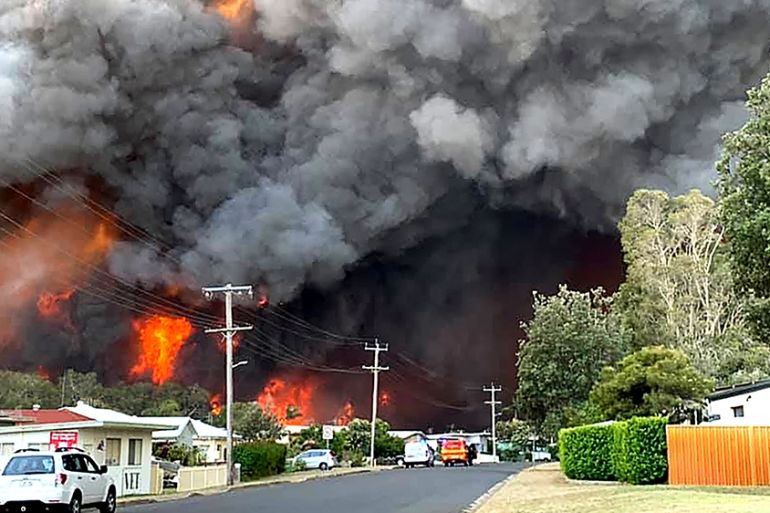Australia braces for ‘catastrophic’ conditions as bushfires rage
At least three people have been killed and 150 homes razed as one of the country’s worst bushfire seasons continues.

Firefighters in Australia are racing to tackle devastating bushfires that have left three people dead, with authorities warning of perilous conditions ahead, including around the country’s biggest city of Sydney.
In a statement on Sunday, the New South Wales state Rural Fire Service upgraded the forecast for the greater Sydney region to “catastrophic fire danger” this coming Tuesday. It is the first time the area has been rated at the highest level since new fire danger ratings were introduced in 2009.
Keep reading
list of 3 itemsFeeling the heat: Australia offers drought-hit farmers loans
Drought-stricken rural Australia welcomes rains
“High temperatures, strong winds and low humidity are forecast, making conditions dangerous,” it said.
Conditions for Tuesday in the greater Hunter Region north of Sydney were also rated as catastrophic, the highest level of bushfire danger, while extreme or severe conditions were predicted for other parts of the state.
“If a fire starts and takes hold during catastrophic fire danger conditions, lives and homes will be at risk,” the statement said.
Three people have died in New South Wales since Friday, when a record number of emergency-level fires were declared in the state, and at least 150 homes have been destroyed.
“We are ramping up for probably another 50 trucks full of crews to be deployed into New South Wales on Monday night ahead of conditions on Tuesday,” NSW Rural Fire Service Commissioner Shan Fitzsimmons told reporters in Taree, one of the worst-hit areas.
“We have seen the gravity of the situation unfold … What we can expect is those sorts of conditions to prevail across a much broader geographic area as we head into Tuesday.”
Ross Bradstock, from the Centre for Environmental Risk Management of Bushfires at the University of Wollongong, described the situation as “unprecedented” for the affected regions, which have rarely – if ever – experienced such severe fires.
“Sadly, given the weather forecast for the coming week, the crisis may worsen and extend southward into landscapes primed to burn via extreme dryness,” he said.
Five people were listed by authorities as missing on Saturday afternoon, but local media said on Sunday they had now been accounted for.
The unpredictable nature of the disaster means officials have not ruled out the possibility that others could still be missing, NSW Rural Fire Service spokesman Greg Allan told AFP news agency.
‘Climate change is real, can’t you see‘
By Sunday afternoon, about half of the more than 70 fires burning in New South Wales were still not under control, with two burning at an emergency level.
Education authorities said more than 40 schools in New South Wales would be shut on Monday due to the fires.
Further north in Queensland, more than 50 fires were burning on Sunday, with emergency warnings in place for two fires.
|
|
Thousands of residents in Queensland have been evacuated and authorities warned severe fire danger was expected on Wednesday.
“There is really no rainfall, no significant rainfall, until at least the end of the year and possibly into the new year,” Queensland Fire and Emergency Services acting commissioner Mike Wassing told a news conference on Sunday.
Many residents, meanwhile, are returning to their scorched communities to assess the extent of the fire-inflicted damage, amid warnings it could take months for them to rebuild their lives.
Emotions were running high at an evacuation centre in Taree, with one man breaking down in tears as he was embraced by Prime Minister Scott Morrison.
“People are under a lot of pressure,” Morrison told reporters. “The level of optimism, despite the circumstances, is quite inspiring.”
Morrison, whose government has downplayed the threat of climate change, was also heckled about the issue at a fire command centre in nearby Wauchope.
“Climate change is real, can’t you see,” the Australian newspaper reported a man as yelling before he was escorted out of the building.